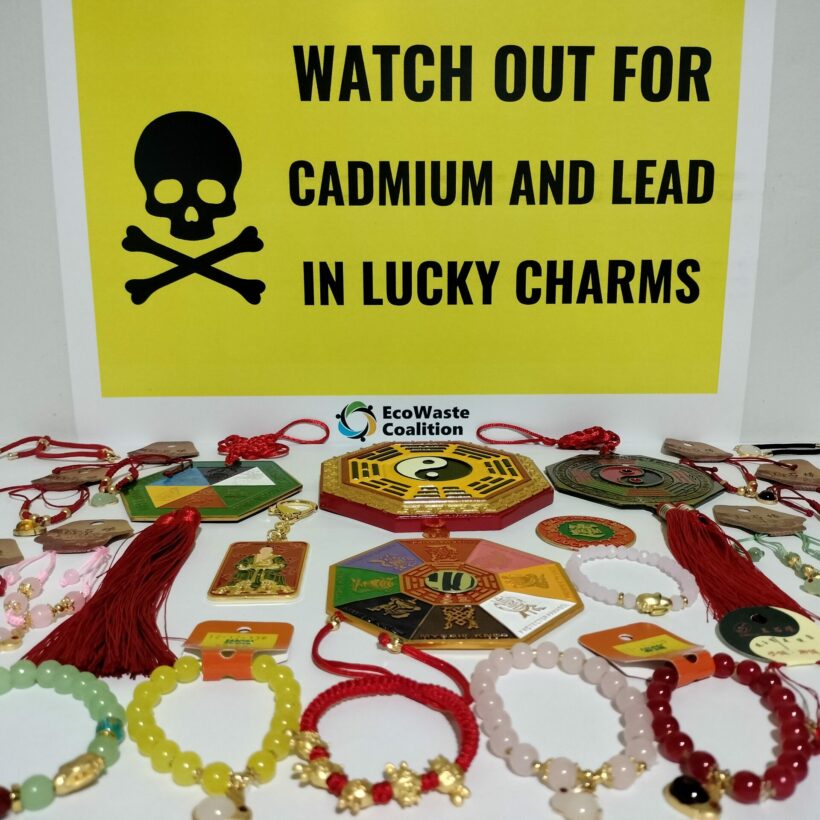Group tells manufacturers to label their products and provide hazard warnings
18 January 2023, Quezon City. As the Chinese Lunar New Year approaches, the toxics watchdog group EcoWaste Coalition cautioned luck seekers from purchasing charms and amulets containing highly hazardous chemicals cadmium and lead.
“Some amulets and charms that claim to attract or boost ‘Sheng Chi’ (good energy) and counter ‘Sha Chi’ (bad energy) are unluckily laden with high levels of cadmium and lead,” said Aileen Lucero, National Coordinator, EcoWaste Coalition.
“These chemicals are highly hazardous and are known to negatively affect human health and the environment,” she said, “We, therefore, question their presence in charms and amulets that are marketed to enhance good health, happiness, long life, and prosperity.”
In test buys conducted by the EcoWaste Coalition ahead of the celebration of the Chinese Lunar New Year of the Water Rabbit, 23 of the 35 lucky charms and amulets purchased from retailers in Binondo and Quiapo, Manila were found to contain high levels of cadmium and lead.
17 bracelets with rabbit-inspired metallic components were found to contain cadmium above the European Union’s 100 parts per million (ppm) limit for cadmium in metal parts of jewelry and imitation jewelry. Of these 17 bracelets, 11 had over 100,000 ppm cadmium, five had 19,690 ppm to 78,200 ppm, and one had 553 ppm.
Six other products were found to be coated with paints containing lead above the 90 ppm total lead content limit under the DENR-issued Chemical Control Order for Lead and Lead Compounds.
Cadmium and lead, the EcoWaste Coalition pointed out, belong to the Philippine Priority Chemical List and to the 10 chemicals or groups of chemicals of major public health concern according to the World Health Organization (WHO).
Cadmium, according to the WHO, “exerts toxic effects on the kidneys as well as the skeletal and respiratory systems (and) is classified as a human carcinogen,” while lead is considered as “a cumulative toxicant that affects multiple body systems, including the neurologic, hematologic, gastrointestinal, cardiovascular, and renal systems.”
Among the items found to be decorated with lead paints above 90 ppm were:
— A black and white “Yinyang” bagua with 26,720 ppm (yellow); 867 ppm (black), 487 ppm (green), and 441 ppm (red).
— A lucky charm to protect users against the “San Sha” (or “Three Killings,” namely financial, health and career problems) had 7,039 ppm (yellow) and 2,066 ppm (green).
— A bagua with a mirror and eight auspicious symbols of good luck had 6,317 ppm (yellow) and 873 ppm (green).
— A “Tau Sui General Pi Shi” amulet that is supposed to protect certain people whose Zodiac signs are against Tai Sui (Grand Duke) had 4,030 ppm (green).
— A “Golden Dragon Lucky Coin” that is recommended as a good gift for friends and relatives had 3,805 ppm (green).
— A black and red bagua with tassel had 3,647 ppm (red), 2,008 ppm (green) and 291 ppm (black).
The group performed the chemical screening of the above products using a handheld Olympus Vanta M Series X-Ray Fluorescence (XRF) analyzer.
“Manufacturers should properly label their products, including providing hazard warnings, to help consumers make informed choices,” she suggested. “Consumers have the inherent right to be informed, including the right to know about chemical substances in products.”
Instead of unlabeled charms and amulets that may contain hazardous chemicals, the EcoWaste Coalition again pitched for the tried and proven recipes for good health, success and happiness such as healthy and non-toxic lifestyle, hard work and perseverance, loving and caring relationships, positive outlook in life, prayers and good deeds, and respect for Mother Earth, to name a few.
Reference:
https://www.who.int/news-room/photo-story/photo-story-detail/10-chemicals-of-public-health-concern










